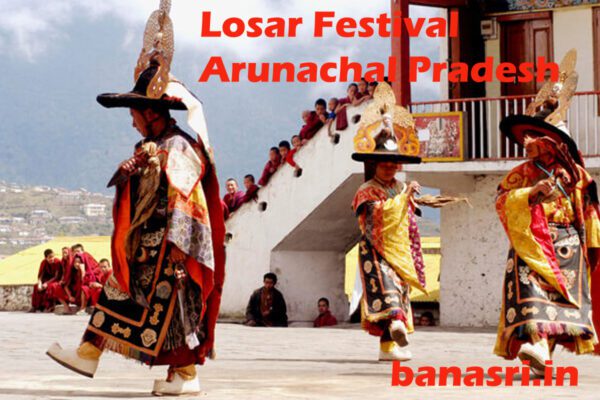
Losar Festival, Arunachal Pradesh: Celebrating the Tibetan New Year
Introduction
The Losar Festival is a vibrant and significant cultural celebration observed primarily by the Monpa tribe of Arunachal Pradesh, India, and by Tibetan communities worldwide. It marks the Tibetan New Year and is characterized by religious rituals, traditional performances, and community gatherings. The festival holds deep cultural and spiritual significance for the people of Arunachal Pradesh, especially those of Tibetan descent.
Timing of the Festival
- When: The Losar Festival is celebrated according to the Tibetan lunar calendar, usually falling between January and March.
- Significance: It marks the beginning of the Tibetan New Year and is a time for spiritual renewal, family reunions, and cultural festivities.
Locality of the Festival
- Where: The festival is prominently celebrated in Tawang and West Kameng districts of Arunachal Pradesh, where Monpa communities are concentrated.
- Importance: Tawang Monastery, one of the largest and most revered monasteries in the region, serves as a focal point for the festivities.
Nature of the Festival
- Type: Losar Festival is both a religious and cultural festival, blending Buddhist rituals with traditional folk customs.
- Essence: It emphasizes the renewal of spiritual vows, purification rituals, and cultural practices aimed at fostering community cohesion.
Highlights of the Losar Festival
Rituals and Religious Observances
- Offerings and Prayers:
- Rituals: Monks perform elaborate rituals at monasteries, offering prayers and performing ceremonies to dispel negativity and invoke blessings for the New Year.
- Significance: The rituals aim to purify the environment and promote prosperity, health, and happiness for the community.
- Specialty: Butter sculptures (tormas), mandala offerings, and chanting of sacred texts are integral parts of the religious observances.
- Cham Dances:
- Performance: Monks and lamas perform traditional masked dances, known as Cham dances, depicting religious stories and legends.
- Purpose: Cham dances are believed to ward off evil spirits and bring blessings for the coming year.
- Specialty: The colorful costumes, intricate masks, and rhythmic movements of Cham dances captivate audiences and impart spiritual teachings.
Cultural Traditions and Customs
- Folk Performances:
- Entertainment: Local artists and performers showcase traditional folk dances, music, and theatrical performances.
- Significance: These cultural performances celebrate Monpa heritage and entertain the community and visitors.
- Specialty: Dances like Aji Lhamu and Ponung are performed, accompanied by traditional musical instruments like drums, cymbals, and wind instruments.
- Feasting and Family Gatherings:
- Celebrations: Families gather for elaborate feasts, exchanging gifts and offering prayers for good fortune and prosperity.
- Importance: Losar is a time for family reunions, strengthening bonds, and sharing blessings with loved ones.
- Specialty: Traditional dishes such as thukpa (noodle soup), momos (dumplings), and sweet rice are prepared and enjoyed during the festivities.
Symbolism and Cultural Significance
- Butter Lamps and Fire Rituals:
- Lighting Lamps: Butter lamps are lit at homes and monasteries to symbolize the dispelling of darkness and ignorance.
- Fire Rituals: Bonfires are lit to symbolize the burning away of negative influences and to welcome positive energy for the New Year.
- Specialty: The glow of butter lamps and the warmth of bonfires create a serene and auspicious atmosphere during Losar.
- Astrological Observances:
- Astrological Readings: Monks and lamas consult astrological charts and conduct divinations to forecast the year ahead.
- Purpose: This practice guides individuals in making decisions and preparing for the challenges and opportunities of the coming year.
- Specialty: Astrological advice and blessings from monks are sought by families and individuals seeking guidance and protection.
Specialty of Losar Festival
- Cultural Diversity: Losar Festival celebrates the unique blend of Tibetan Buddhist traditions with local Monpa customs, highlighting Arunachal Pradesh’s cultural diversity.
- Spiritual Renewal: It marks a period of spiritual reflection, purification, and renewal of vows among Buddhist practitioners.
- Community Bonding: Losar fosters strong bonds within families and communities through shared rituals, feasting, and cultural performances.
- Tourist Attraction: The colorful festivities, religious rituals, and cultural performances during Losar attract tourists interested in experiencing Tibetan and Monpa culture firsthand.
Conclusion
The Losar Festival in Arunachal Pradesh is a joyous and spiritually enriching celebration that honors Tibetan Buddhist traditions and Monpa heritage. Through its rituals, religious observances, cultural performances, and community gatherings, Losar brings together people of diverse backgrounds to usher in the New Year with hope, prosperity, and unity. It remains a cherished occasion that showcases the vibrant cultural tapestry of Arunachal Pradesh while reaffirming the values of compassion, harmony, and spiritual growth within the community.

I am really inspired along with your writing skills
and also with the structure in your weblog.
Is this a paid subject matter or did you modify it your self?
Anyway stay up the nice quality writing, it is rare to look a
great weblog like this one today. Madgicx!